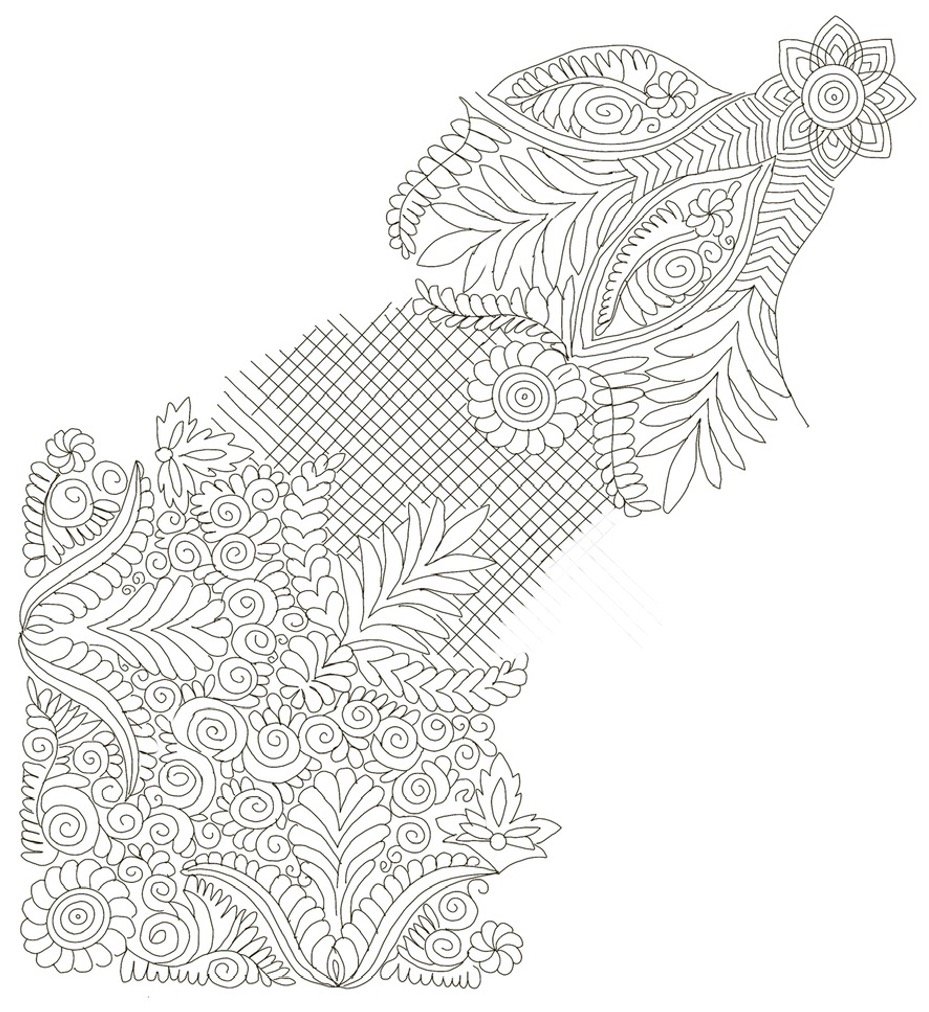What is frame quilting?
The quilt frame, and the rocking quilting stitch which accompanies it, are previously ubiquitous tools and skills that have been allowed to fall almost out of use throughout Scotland, England, Wales, Ireland, and Northern Ireland.
Almost all quilts from these regions were once quilted in a flat frame. This unique partnering of a skill and tool shaped the style and look of all extant quilts for 300 years and more. As such the practice has a distinct history which at times overlaps more familiar patchwork chronologies, but is not the same.
Quilting was traditionally paid labour, undertaken by marginalised people, both men and women. Where it was a domestic undertaking in the 19th and 20th centuries, it tended to thrive in provincial areas characterised by farming, mining and coastal fishing communities. The intersection of gender, domesticity, class and geography have compounded the neglect of this skill within formal sources and histories of art.
Elaborate patchwork, by contrast, since the late eighteenth century was most often a middle-class leisure occupation, and as such it has a rich and evolving historiography.
The modern identity of ‘quilter’ has come to mean ‘patchworker’, Within the Frame seeks to bring back an important overlooked historical distinction, encouraging a contemporary understanding and practice of the traditional skills of ‘quilting’ through the propagation of the tools, and an understanding of the identity, of the original ‘quilters’ across this land.
{Image: Mrs Lace and Mrs Olivia Evan demonstrating at the Welsh Folk Museum during the ‘1951 Quilting Conference’ Museum Wales. 35/19070.}
A brief history of frame quilting
Women and men earning a living through their quilting skills appear in the record as early as the thirteenth century in Britain, working in a practice which endured in the Welsh valleys and across the north of England until the middle of the twentieth century.
Quilting was an associated skill to other forms of textile embellishment, such as embroidery, and was undertaken in professional studios and in the home. Quilting was marginal work for both men and women. At home, quilting was a domestic labour.
Through the 18th century quilting added warmth, structure and decoration to a huge range of clothing and domestic textiles across the class spectrum. Quilt frames appear as devices in literature and in newspaper advertisements, in wills and inventories and in theft cases heard in court.
The history of quilting then collided with the separate strand of patchwork at the start of the nineteenth century where elaborately patched and quilted bed covers were made by middling and labouring women, at home across the British Isles.
By the end of the nineteenth century quilting practice had retreated from the urbanised South East and industrial North and was harboured in pockets of rural Britain; in Wales, Northern Ireland and across the upland north where it became a reflection of a gendered and community identity, whilst providing still-useful and practical objects of warmth and durability.
These regions were also characterised by poor alternative employment opportunities for women and unreliable male wage patterns associated with mining, harvest and fishing. Paid quilting services, therefore, became an important subsistence addition to families, or a way for lone women and elderly or disabled men to support themselves.
Innovative and intensely local economic traditions were established around this gendered labour as women sought ways to bolster against poverty and insecurity. These women were often marginalised, sometimes disabled, most often supporting dependents without a male living wage.
In the first decades of the twentieth century the state, in the form of the Rural Industries Bureau (RIB), involved itself in quilting, linking elite urban customers for hand stitched quilts with provincial makers as an economic bolster against the 1930s depression in the southern Welsh and northern English mining communities.
To study the history of quilting in the British Isles is to access an often overlooked story of working-class, skilled, entrepreneurial, but marginalised women. Normative approaches to gender, class, geography and domesticity obscured them but the strikingly bold and elegant quilts that they made preserve these stories if we care to look.
Appreciating extant quilts as sources requires an understanding of the tools and techniques which formed them. A failure to interrogate the historiography has led to a compounding neglect in the propagation of this skill. Without the rejuvenation of these skills we also risk a degradation in the understanding of the material culture of these objects, and the communities they represent.
{Image: ‘Quilt Wives Holding a Quilt 1928’. Museum Wales Collection.}

Want to learn more?
Explore our recommended reading list & collections.

